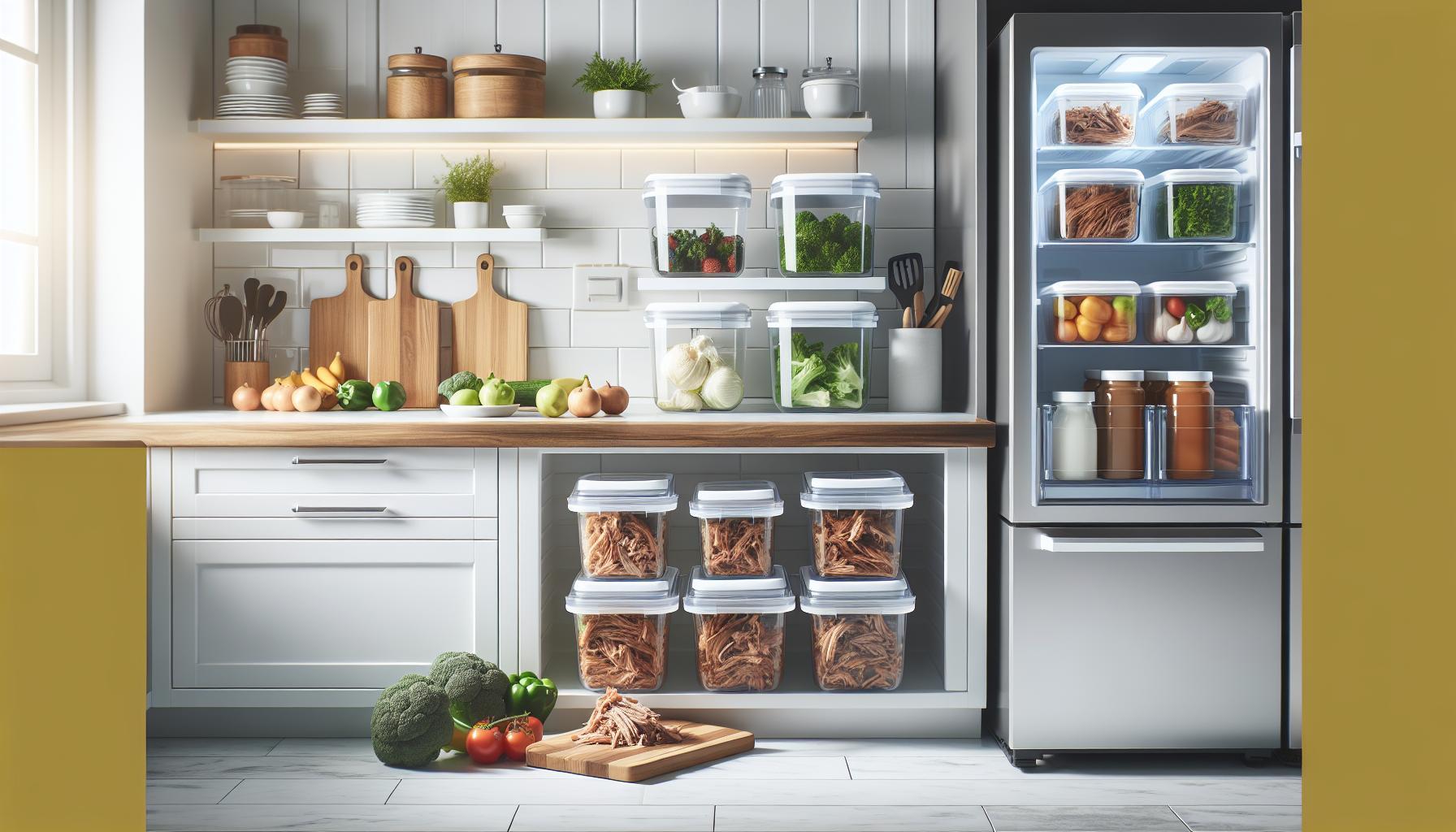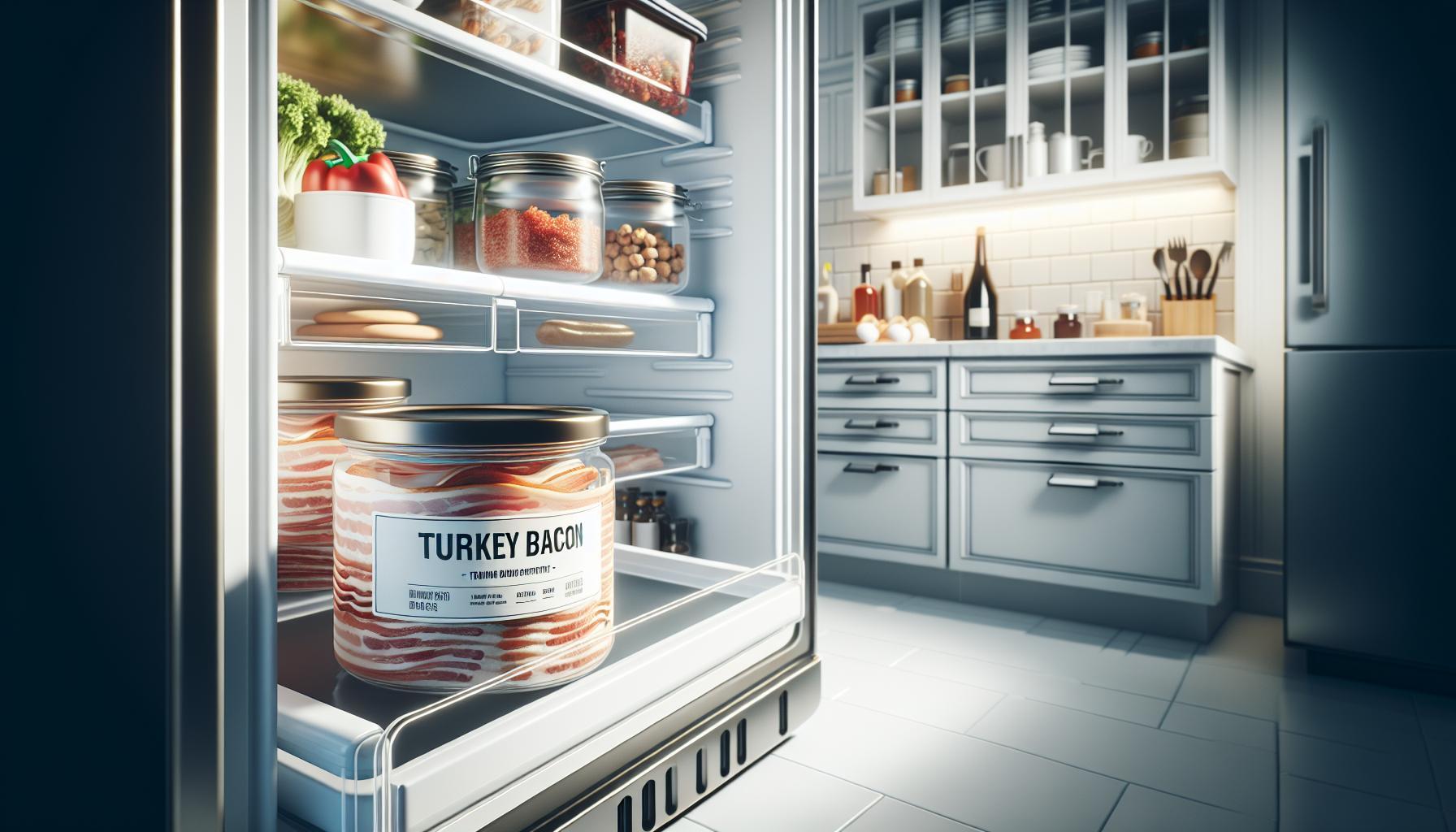If you’re a fan of pulled pork, you know its delectable flavors can linger long after the meal is over. But have you ever wondered how long you can safely store this tasty treat in your fridge? Understanding the lifespan of pulled pork is essential for preserving its mouthwatering qualities without risking your health.
Proper storage can maximize not just the longevity but also the enjoyment of your leftovers, allowing you to savor every bite. Whether you’re planning meal prep or just want to avoid waste, knowing the answers can mean the difference between a safe snack and a lost opportunity. In this guide, we’ll explore how long pulled pork lasts, the best storage practices, and tips for enjoying it while it’s at its best. Let’s dive into the delicious details!
Understanding Pulled Pork Storage Safety
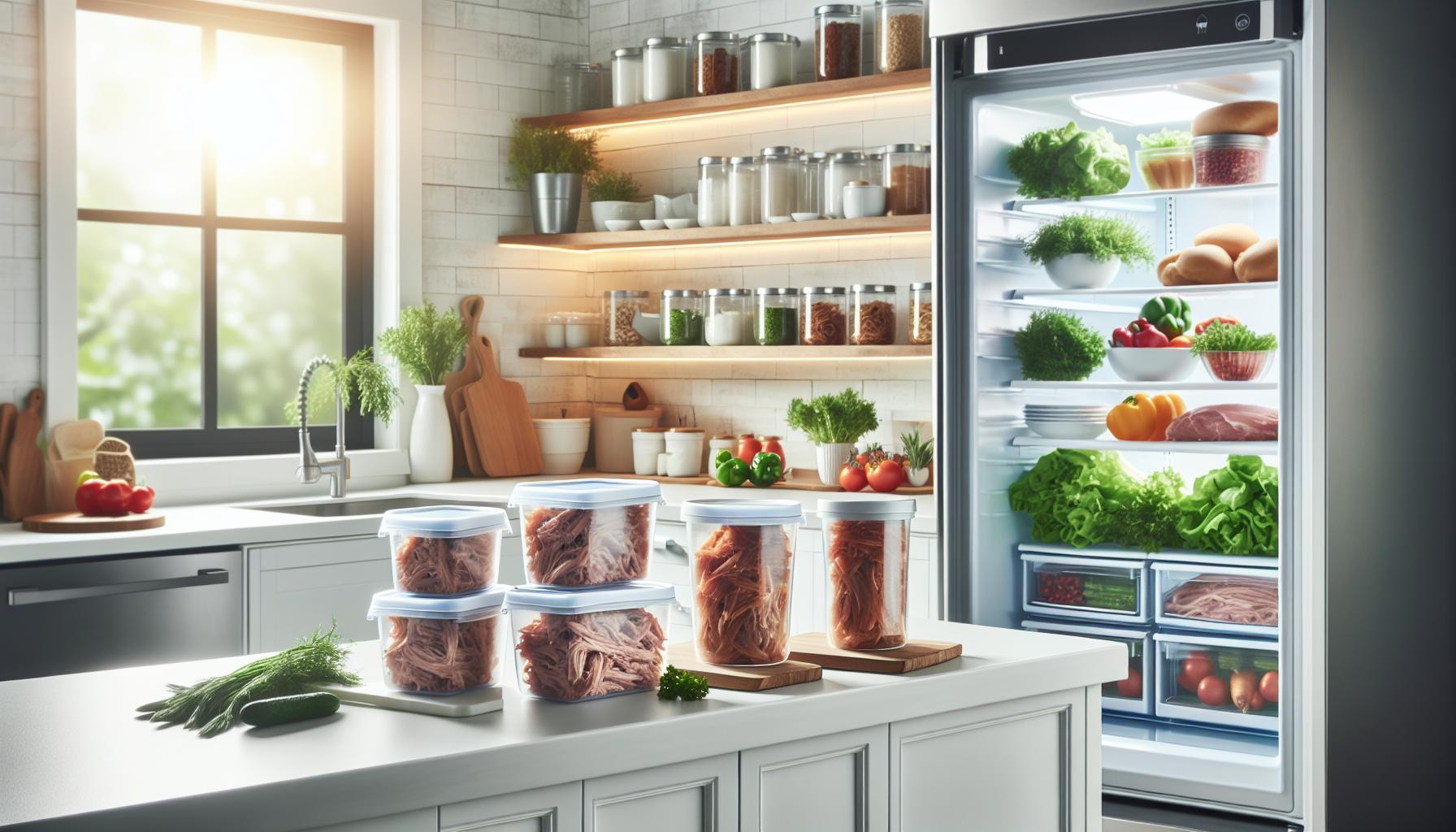
Understanding how to store pulled pork safely is essential for enjoying its deliciousness while preventing foodborne illnesses. Pulled pork, whether homemade or store-bought, should be handled with care from the moment it’s cooked. Proper storage can help maintain its flavor and texture, allowing you to enjoy this favorite dish long after the feast is over.
When storing pulled pork, the first rule is to cool it quickly if it has been freshly made. Allowing the pork to sit out at room temperature can promote the growth of bacteria. It’s recommended to refrigerate pulled pork within two hours of cooking. If the pork is particularly hot, you can divide it into smaller portions to cool down more rapidly. Store the pork in airtight containers or vacuum-sealed bags – this minimizes exposure to air and helps retain moisture.
In the refrigerator, pulled pork can last for up to four days when stored correctly. Make sure your fridge is set to 40°F (4°C) or lower to inhibit bacterial growth. If you don’t plan to eat it within this time frame, freezing the pulled pork is an excellent option. It can last up to three months in the freezer without losing its quality. When thawing frozen pulled pork, it’s crucial to do so safely in the refrigerator or using the defrost setting on your microwave. Avoid leaving it out to thaw at room temperature, as this can allow harmful bacteria to thrive. By following these safety measures, you can enjoy your pulled pork with peace of mind, making each bite just as flavorful as the first.
Ideal Storage Conditions for Pulled Pork
To keep pulled pork fresh and flavorful, understanding the ideal storage conditions is crucial. Properly storing pulled pork helps prevent foodborne illnesses and ensures that every bite remains as delicious as possible. The first step in proper storage is to cool the pork quickly after cooking. Leaving it out at room temperature for extended periods allows harmful bacteria to thrive. Aim to refrigerate pulled pork within two hours of cooking. If the pork is still hot, consider dividing it into smaller portions to speed up the cooling process, thus further reducing the risk of bacterial growth.
When it comes to packaging, use airtight containers or vacuum-sealed bags to minimize air exposure, which keeps the pork moist and helps prevent freezer burn. For optimal refrigeration, ensure your fridge is set to 40°F (4°C) or lower. Under these conditions, pulled pork can safely last for up to four days. If you have more than you can consume within this time frame, freezing is an excellent alternative; it can retain quality in the freezer for up to three months.
To help maintain flavor and texture, label containers with the date of storage and consider using a portioning method that allows you to take out only what you need for a meal. This will not only make reheating easier but also ensure that the remaining pork stays sealed until it’s time to enjoy more of it.
How Long Does Pulled Pork Last Unopened?
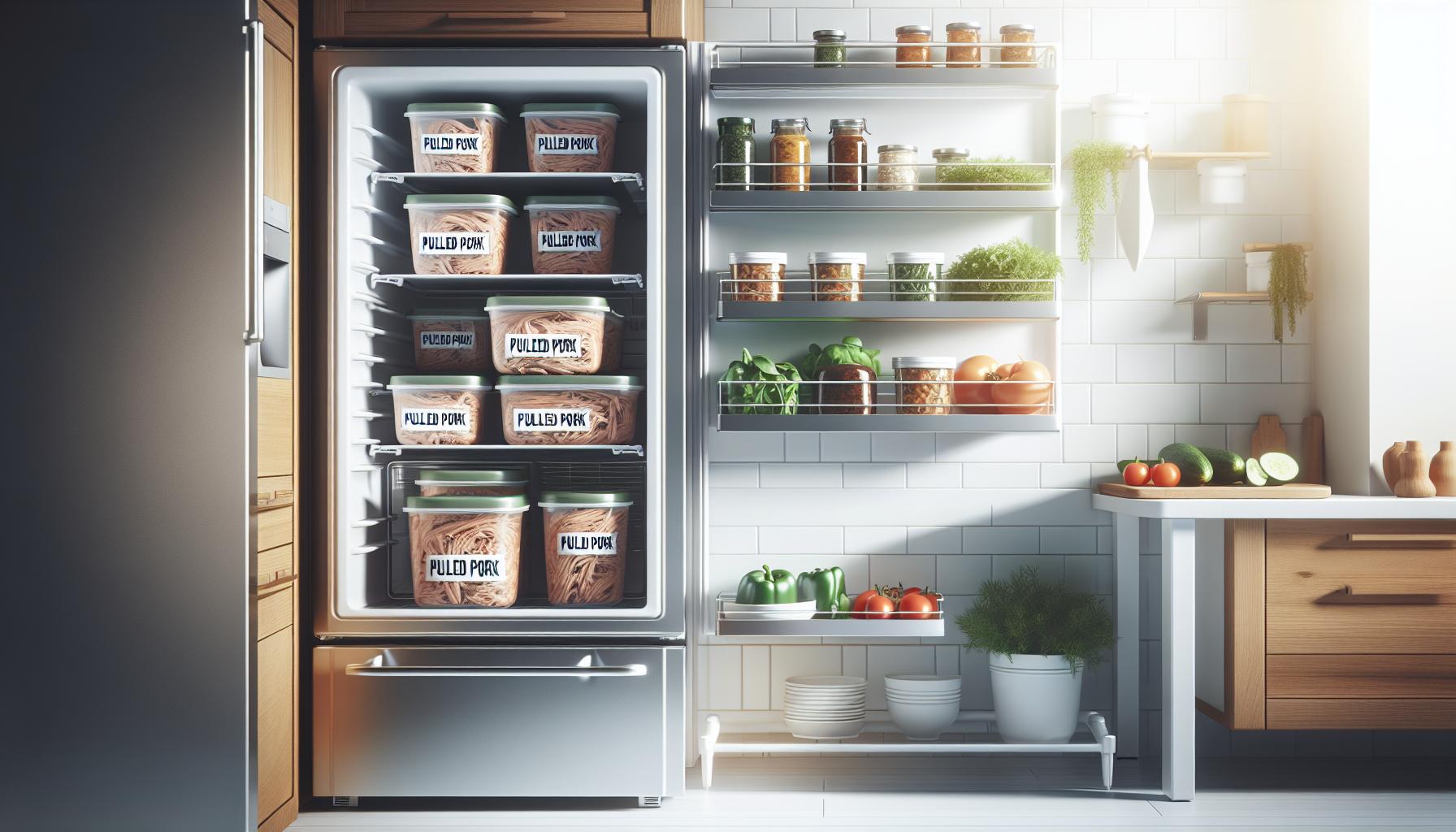
Pulled pork, when stored properly, can be a delicious meal option over several days. If you purchase pulled pork that is unopened and vacuum-sealed, it can be a convenient choice for busy home cooks. Generally, unopened pulled pork can last in the refrigerator for up to two weeks if it remains sealed and your fridge is kept at a consistent temperature of 40°F (4°C) or lower. This makes it an excellent option for planning meals ahead without the stress of imminent spoilage.
It’s important to check the sell-by or use-by date printed on the packaging as a guideline, as this indicates the period during which the pork will maintain its best quality. While unopened pulled pork may still be safe to eat for a short time after this date if it has been stored correctly, it’s crucial to rely on visual and sensory cues. If the packaging is intact and there’s no sign of bulging, discoloration, or an off smell when you open it, the pork should be safe to consume.
In addition to refrigerated storage, unopened pulled pork can also be frozen. If you know you won’t be able to consume it within two weeks, freezing is an excellent alternative. Pulled pork can maintain its best quality in the freezer for up to three months without significant loss of flavor or texture. Just be sure to wrap it in airtight packaging to prevent freezer burn, helping you enjoy tasty pulled pork dishes at your convenience.
Opened Pulled Pork: Shelf Life Guide
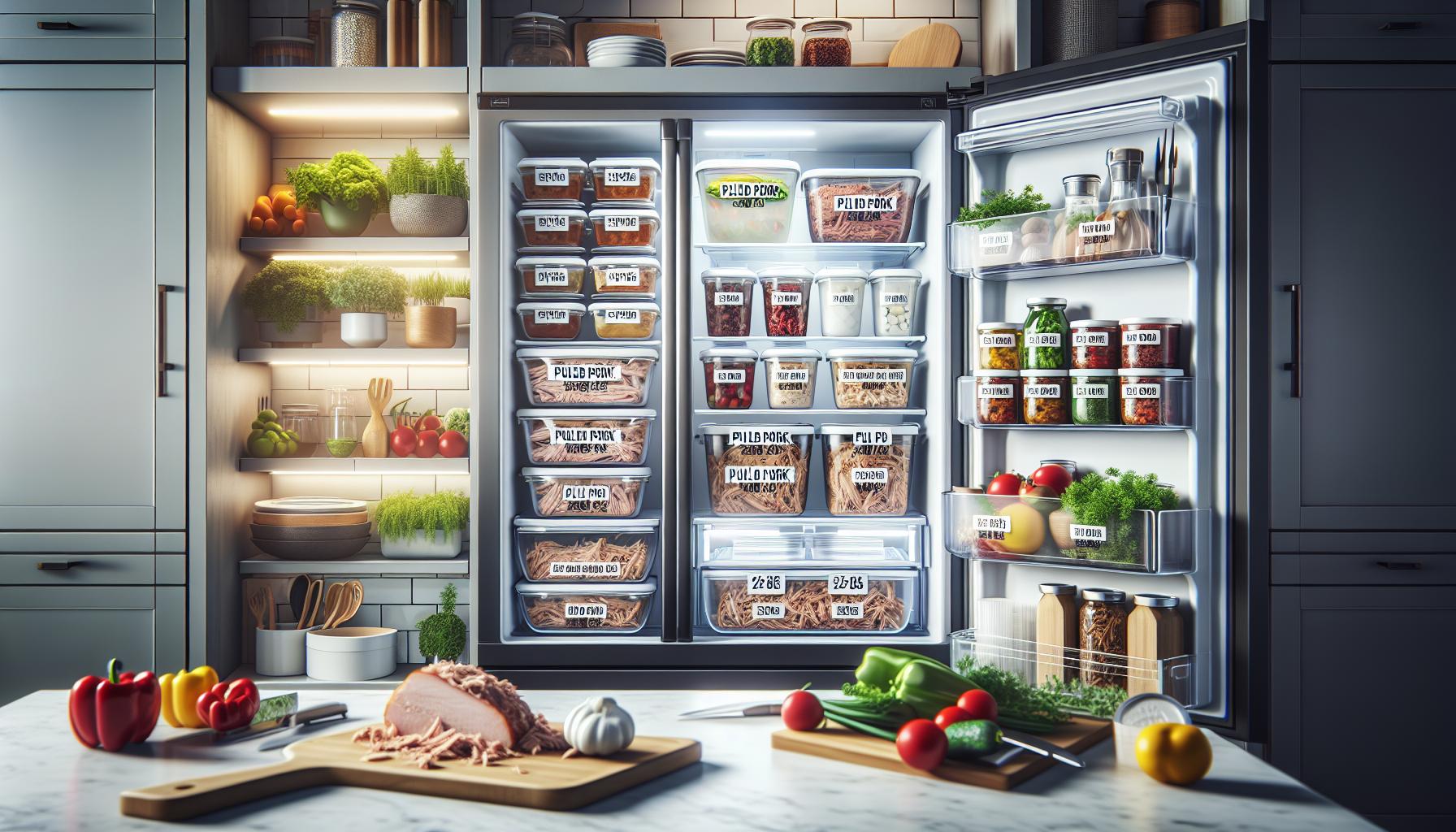
Opened pulled pork can be a delightful and convenient meal option, but it requires careful storage to ensure safety and maintain quality. Once you’ve opened your container of pulled pork, it’s essential to consume it within a specific timeframe to minimize the risk of foodborne illnesses. Properly stored in the fridge at or below 40°F (4°C), opened pulled pork can last for about 3 to 4 days. This guideline applies whether you’ve purchased it from a market or made it at home; both scenarios require similar handling practices to ensure freshness.
To maximize the shelf life of opened pulled pork, it’s important to store it in an airtight container or tightly sealed plastic wrap. This reduces exposure to air, which can contribute to spoilage. If you’ve noticed that the pork has come into contact with any utensil or contaminated surface, consider reheating it to a safe internal temperature of 165°F (74°C) before consuming leftovers. Not only does this practice help eliminate any lingering bacteria, but it also revitalizes flavors that might have diminished over time.
While the 3 to 4 days guideline is a good rule of thumb, always rely on your senses to judge the meat’s freshness. Signs that your opened pulled pork may have expired include unusual odors, changes in color or texture, and the presence of mold. If you’re in doubt, it’s best to err on the side of caution and discard the pork; better safe than sorry when it comes to food safety. By following these guidelines, you can safely enjoy your opened pulled pork and make the most out of your delicious meal preparations.
Identifying Spoiled Pulled Pork
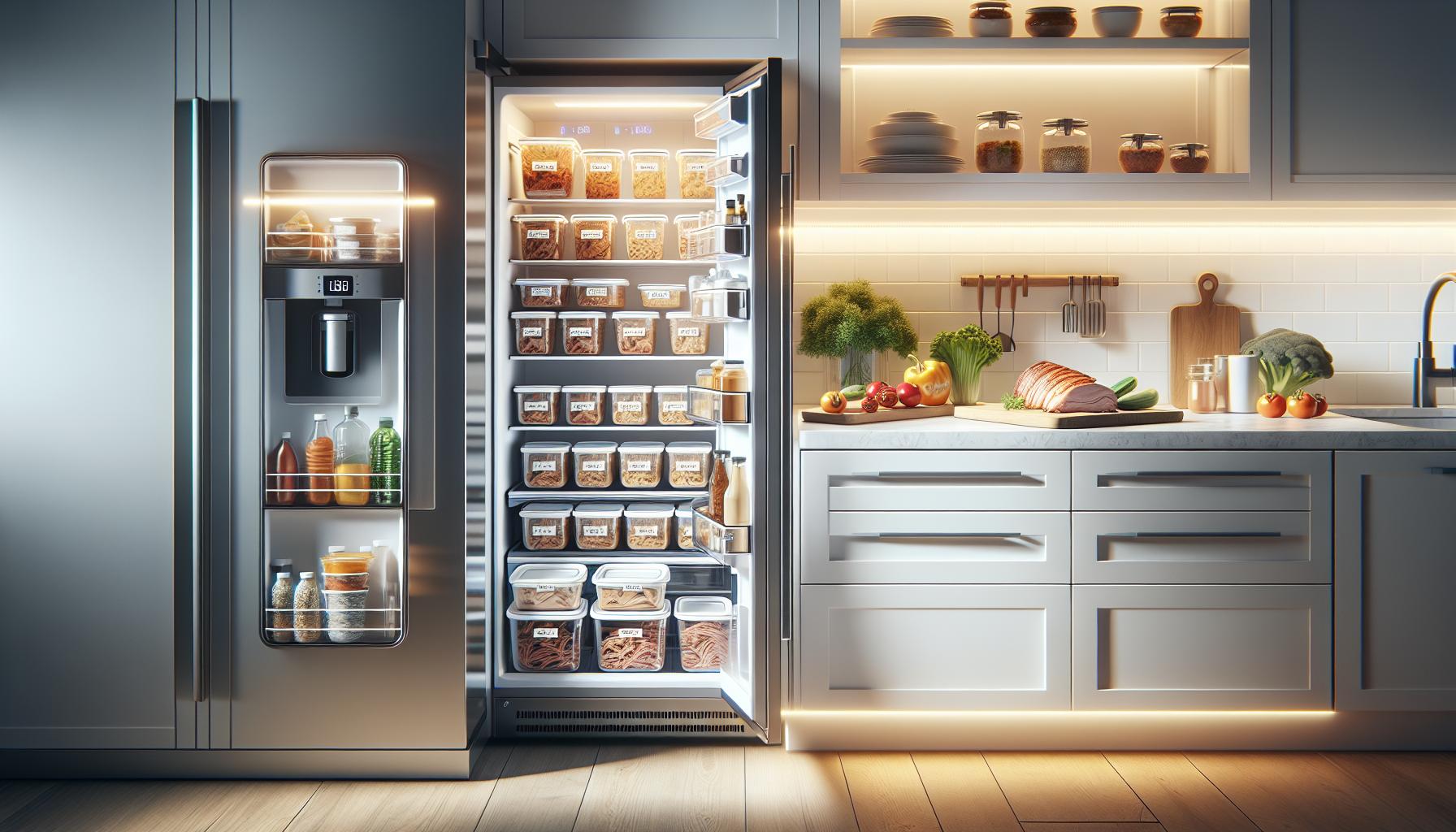
When it comes to enjoying pulled pork, ensuring its safety is paramount. Spoiled pulled pork can be hazardous, so learning to identify its signs of spoilage is essential for safe consumption. One of the most noticeable indicators of spoiled pulled pork is an unpleasant odor. Fresh pulled pork typically has a savory, rich smell, but if it starts to emit a sour, rancid, or off-putting scent, that’s a clear red flag that it has gone bad.
Visual cues are also crucial in determining the freshness of your pulled pork. Fresh meat should have a uniform color, usually a pinkish hue. If you notice any significant discoloration-such as a brown or grey tint-or the presence of mold, it’s best to act quickly and discard the meat. Additionally, if the texture has changed and the pork feels slimy or sticky to the touch, these are also signs that it has spoiled and should not be consumed.
It’s important to remember that even if the pulled pork looks and smells fine, it might still harbor harmful bacteria if it has been stored improperly or kept past the safe consumption period. Always adhere to the guideline of consuming opened pulled pork within 3 to 4 days when stored in the refrigerator at or below 40°F (4°C). To further ensure your safety, when in doubt about the freshness of your pulled pork, it’s better to err on the side of caution and discard it rather than risk foodborne illness.
By being vigilant about these signs of spoilage and adhering to proper storage practices, you can enjoy delicious pulled pork without worry.
Best Practices for Reheating Pulled Pork
To truly savor the rich, smoky flavors of pulled pork, proper reheating techniques are essential. Reheating not only brings back the comforting warmth but also maintains the deliciousness of your leftovers. However, achieving the perfect temperature and texture requires careful attention to methods that can help you avoid dry or rubbery pork.
Switching on your oven is one of the best ways to reheat pulled pork evenly while preserving its moisture. Preheat it to 250°F (121°C) and place your pulled pork in an oven-safe dish. To keep it succulent, add a splash of broth or barbecue sauce, cover the dish tightly with aluminum foil, and reheat for about 30-45 minutes, or until it reaches an internal temperature of 165°F (74°C). This method helps maintain the flavor and juiciness, avoiding the risk of drying out your meal.
If you’re short on time or prefer a quicker method, using a microwave can also work, albeit with a less favorable texture. Place your pulled pork in a microwave-safe container, add a small amount of liquid (broth or juice) for moisture, and cover it with a microwave-safe lid or wrap to trap steam. Heat it on medium power in 30-second intervals, stirring occasionally to ensure even heating. This keeps the meat moist and helps reduce the chances of tough or chewy bites.
For those who enjoy a bit of extra crispiness, returning pulled pork to a skillet can enhance its flavor profile with a slight caramelization. Heat a skillet over medium heat and add a drizzle of oil. Once hot, add the pulled pork and stir occasionally until warmed through. For added depth, toss in a bit of additional seasoning or barbecue sauce. This method not only warms the pork but can also revive crusty edges reminiscent of freshly made pulled pork.
Regardless of your method, safety should always come first. Ensure all reheated pulled pork reaches an internal temperature of 165°F (74°C) to effectively kill any lingering bacteria. By following these practical reheating strategies, you can easily transform your leftovers into a delectable new meal, ready to enjoy while keeping food safety at the forefront.
Creative Ways to Use Leftover Pulled Pork
Leftover pulled pork is not only versatile but can also be the key to elevating a variety of dishes, turning humble ingredients into culinary delights. With its rich, smoky flavor and tender texture, pulled pork can be repurposed in countless ways, ensuring that every bite is both satisfying and inventive. Here are some creative ways to make the most of your leftover pulled pork while keeping food safety in mind.
One simple yet delicious option is to create pulled pork quesadillas. Start by taking two flour tortillas and layering one side with cheese, then adding a generous portion of pulled pork and maybe a spoonful of barbecue sauce or fresh cilantro for added zest. Fold the tortilla in half and cook it on a skillet until both sides are crispy and the cheese has melted. These quesadillas make for a quick meal or a delightful snack.
Another great idea is to use pulled pork as a flavorful topping for baked potatoes. Simply bake or microwave russet potatoes until tender, scoop out a bit of the insides, and fill the cavity with warmed pulled pork and a dollop of sour cream or your favorite condiments. This hearty combination provides a filling dish that’s perfect for lunch or dinner.
For something different, consider making pulled pork nachos. Layer tortilla chips on a baking sheet, scatter the warmed pulled pork on top, and sprinkle with cheese, jalapeños, and your choice of toppings. Pop them in the oven until the cheese is bubbly and serve with guacamole and salsa for a crowd-pleasing appetizer or game-day snack.
When utilizing leftover pulled pork, always ensure that it has been stored appropriately. Pulled pork can typically last in the refrigerator for 3 to 4 days. If you’re reaching the end of that timeframe, consider freezing portions for later use. To freeze, place the pulled pork in airtight containers, leaving space for expansion, and label them with the date. They can be stored safely for up to 3 months. Remember to thaw in the refrigerator for at least 24 hours before reheating to maintain quality and safety.
By creatively incorporating pulled pork into various meals, you not only extend its shelf-life but also enhance your culinary repertoire. Enjoy experimenting with these dishes to make the most of your flavorful leftovers!
Freezing Pulled Pork: Tips and Techniques
Pulled pork is a beloved dish known for its smoky flavor and tender texture, making it a perfect addition to various meals. Freezing pulled pork not only extends its shelf life but also preserves its deliciousness for future enjoyment. To freeze pulled pork effectively, it’s crucial to follow certain techniques to maintain its quality and safety. The key is to ensure the meat is cooled down promptly after cooking and stored properly to prevent freezer burn.
First, allow the pulled pork to cool completely at room temperature for no more than two hours. Once cooled, portion the meat into meal-sized servings. Place each portion in an airtight container or heavy-duty freezer bag, squeezing out as much air as possible before sealing. It’s helpful to label each bag with the date and contents to keep track of storage time. For optimal quality, try to consume frozen pulled pork within three months, although it remains safe to eat beyond this period if kept at a consistent freeze.
When ready to use frozen pulled pork, the best practice is to thaw it in the refrigerator, which can take 24 hours or longer, depending on the quantity. A slower thawing process ensures the meat retains its moisture and texture. Avoid thawing at room temperature as this can invite harmful bacteria. After thawing, reheat the pork to an internal temperature of at least 165°F (74°C) before serving to ensure food safety.
To maximize flavor, consider adding a bit of barbecue sauce or other seasonings when reheating. This enhances moisture and restores the dish’s original taste, making your next meal just as enjoyable as the first. Freezing pulled pork is not only a practical solution for meal prep but also a simple way to savor every flavorful bite long after the initial cooking.
How to Safely Thaw Frozen Pulled Pork
To enjoy your frozen pulled pork without compromising its quality or safety, it’s essential to follow specific thawing practices. Thawing frozen pulled pork properly ensures that the meat retains its tenderness and flavor while reducing the risk of foodborne illness. One of the safest ways to thaw pulled pork is to place it in the refrigerator. This method may take a while-up to 24 hours or longer if you’re thawing a large quantity-but it allows the meat to defrost evenly and safely.
When thawing in the refrigerator, make sure to keep the pork in its sealed container or freezer bag. This containment helps prevent cross-contamination with other foods and maintains the pork’s moisture. Once thawed, use the pulled pork within three to four days for the best flavor and safety.
Avoid thawing pulled pork at room temperature, as this can lead to rapid bacterial growth. If you need to thaw the meat more quickly, consider using the cold water method. Submerge the sealed package in a bowl of cold water, changing the water every 30 minutes. While this is faster, be sure to cook the pork immediately after it’s thawed to maintain safety.
To reheat your pulled pork safely, ensure it reaches an internal temperature of at least 165°F (74°C) before serving. This step is critical to eliminate any potential pathogens that might have developed during the thawing process. By following these safe thawing practices, you can relish every delicious bite of your previously frozen pulled pork while keeping food safety at the forefront.
Signs It’s Time to Discard Pulled Pork
Knowing when to discard pulled pork is crucial to ensure food safety and prevent foodborne illnesses. The first red flag for spoiled pulled pork is any off-putting odor. Fresh pulled pork should have a mild, savory smell. If you detect a sour, pungent, or otherwise unpleasant scent, it’s time to throw it out. Additionally, visual cues can indicate spoilage. Look for any unusual discoloration-grayish or greenish hues are signs of spoilage. Also, mold, whether surface level or deeper, is a definitive indicator that the pork should not be consumed.
Texture is another significant factor to consider. Fresh pulled pork should be moist but not slimy. If the meat feels excessively sticky or slimy to the touch, it may have developed harmful bacteria, and disposal is necessary. Pay attention to any excessive liquid accumulation in the storage container, as this can suggest an unpleasant breakdown of the pork.
When considering storage time, pulled pork can typically last in the refrigerator for three to four days when stored properly in an airtight container. Beyond this timeframe, the risk of spoilage increases substantially. If you have kept the pulled pork and are unsure about its freshness, it’s always safer to err on the side of caution. Discarding it will prevent the potential of getting sick, ensuring that meal enjoyment remains a priority. Following these tips will help you savor each bite of pulled pork while maintaining health and safety standards.
Common Pulled Pork Storage Mistakes to Avoid
Storing pulled pork safely is essential for both enjoyment and health. Unfortunately, many people make common mistakes that can jeopardize the integrity of their leftover barbecue. For instance, one frequent error is failing to cool pulled pork quickly before refrigerating it. Leftovers should be placed in the fridge within two hours of cooking. If the pork sits at room temperature for longer, it can reach temperatures that allow harmful bacteria to thrive. An effective method to cool pulled pork rapidly is to transfer it into shallow containers, which increases the surface area and helps it cool faster.
Another pitfall is not using airtight containers for storage. Pulled pork can easily absorb odors from other foods in the fridge or become dry when exposed to air. Storing it in an airtight container or vacuum-sealing it can help maintain moisture and flavor. Additionally, avoid combining fresh pulled pork with used portions, as this can introduce bacteria, leading to spoilage. For best results, portion the pork into smaller quantities based on your meal plans.
Regarding time, some may believe that pulled pork can last indefinitely in the fridge. However, it typically remains safe to eat for just 3 to 4 days. If you’re not planning to use it within this timeframe, consider freezing portions for later enjoyment. While many think freezing dulls flavors, proper wrapping and storage techniques can retain the juicy essence of the meat. Label containers with dates to keep track of how long the pork has been stored.
Lastly, always reheat pulled pork to the right temperature before enjoying it again. The internal temperature should reach at least 165°F (74°C) to ensure any bacteria that may have developed are killed. By adhering to these simple guidelines, you can savor your pulled pork without compromising safety or flavor. Proper storage is key to enjoying every delicious bite.
Maximizing Flavor: Enhancing Leftover Pulled Pork
To elevate the flavor of leftover pulled pork, consider experimenting with various methods to infuse new life into this delicious, versatile dish. Beyond simply reheating, there are creative and easy ways to enhance the taste and texture, ensuring that every bite feels fresh and appetizing.
One of the simplest and most effective methods is to add moisture and flavor through marinades or sauces. Before reheating your pulled pork, toss it in a bit of apple cider vinegar, barbecue sauce, or even a splash of broth to rejuvenate the meat. This not only adds zesty flavors but also helps prevent dryness. For an extra kick, consider mixing in spices or a bit of hot sauce to match your taste preference.
Another fantastic way to maximize flavor is to use your leftover pulled pork in various new dishes. Here are a few suggestions you might want to try:
- Tacos: Serve pulled pork in soft or hard taco shells topped with fresh cilantro, chopped onions, and a squeeze of lime for a vibrant meal.
- Quesadillas: Sandwich the pork between tortillas with cheese and grill until crispy for a quick and satisfying snack.
- BBQ Pulled Pork Sandwiches: Pile the pork on a bun and add coleslaw for texture and a refreshing crunch.
- Pulled Pork Chili: Incorporate the pork into a hearty chili with beans, tomatoes, and spices for a comforting dish.
Additionally, consider utilizing cheese to enhance the richness of the dish. A sprinkle of cheddar or Monterey Jack can create a decadent layer when melted over the reheated pork, making each bite comforting and indulgent.
Finally, don’t overlook the power of garnishes. Fresh herbs, such as parsley or cilantro, can brighten the flavors, while a side of pickled jalapeños can add heat. Remember to reheat the pulled pork to an internal temperature of at least 165°F (74°C) to ensure food safety, and you’ll be ready to enjoy your enhanced leftovers, transforming them into an exciting new meal!
Frequently asked questions
Q: How do I know if pulled pork has gone bad?
A: To determine if pulled pork has spoiled, check for unusual colors, an off smell, or a slimy texture. If it has been stored improperly or for longer than recommended, it’s safest to discard it. Always refer to your “Identifying Spoiled Pulled Pork” section for more details.
Q: Can I store pulled pork in the fridge without sealing it?
A: While it’s possible to store pulled pork without sealing, it’s not advisable. Unsealed meat can dry out and absorb odors from other foods. Always store pulled pork in an airtight container to maintain freshness and quality, as discussed in the “Ideal Storage Conditions for Pulled Pork” section.
Q: What temperature should pulled pork be stored at in the fridge?
A: Pulled pork should be stored in the fridge at or below 40°F (4°C). This prevents bacterial growth. Refer to your “Understanding Pulled Pork Storage Safety” section for more on safe storage practices.
Q: How should I reheat pulled pork to ensure safety?
A: Reheat pulled pork to an internal temperature of 165°F (74°C) to ensure safety. Use a microwave, stovetop, or oven and monitor the temperature with a meat thermometer. For best results, see the “Best Practices for Reheating Pulled Pork” section.
Q: Is it safe to freeze pulled pork after it has been cooked?
A: Yes, it is safe to freeze cooked pulled pork. Store it in airtight bags or containers and consume it within 2 to 3 months for optimal taste. For detailed freezing techniques, refer to the “Freezing Pulled Pork: Tips and Techniques” section.
Q: How long can I keep leftover pulled pork in the fridge?
A: Leftover pulled pork can be safely stored in the fridge for 3 to 4 days. After that, consumption is not recommended. Please see the “Opened Pulled Pork: Shelf Life Guide” section for additional guidelines.
Q: What are the best ways to use leftover pulled pork?
A: Leftover pulled pork can be used in tacos, sandwiches, or salads. It’s versatile and can be easily incorporated into various dishes. Explore creative ideas in your “Creative Ways to Use Leftover Pulled Pork” section for inspiration.
Q: Can you get sick from eating old pulled pork?
A: Yes, consuming spoiled pulled pork can lead to foodborne illnesses. Always check for signs of spoilage and adhere to safe storage principles. Refer to both the “Identifying Spoiled Pulled Pork” and “Signs It’s Time to Discard Pulled Pork” sections for safety guidelines.
Key Takeaways
Now that you know how long pulled pork lasts in the fridge, make the most of your leftovers by enjoying them within 3 to 4 days for optimal taste and safety. Don’t forget to check out our related articles on proper food storage techniques and delicious pulled pork recipes to keep your culinary creativity flowing. Share your thoughts or any tips you have in the comments below-we’d love to hear from you! For more food safety insights and delightful dishes, consider subscribing to our newsletter. Your journey to culinary excellence doesn’t stop here; explore our site for more valuable resources and tips. Remember, safe storage means you can savor every bite of your pulled pork with confidence!

